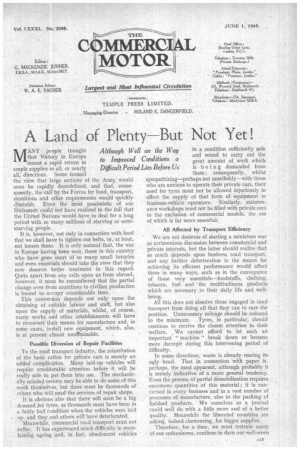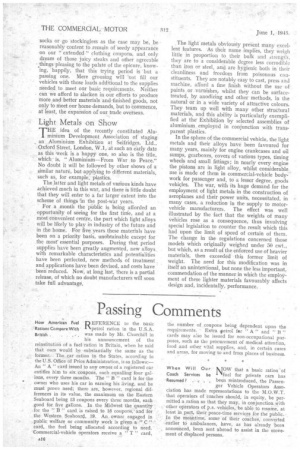A Land of Pletity But Not Yet!
Page 17

Page 18

If you've noticed an error in this article please click here to report it so we can fix it.
MANY people thought that Victory in Europe meant a rapid return to ample supplies in all, or nearly all, directions. Some formed the view that large sections of the Army would soon be rapidly demobilized, and that, consequently, the call by the Forces for food, transport, munitions and other requirements would quickly diminish. Even the most pessimistic of our Statesmen could not have realized to the full that the United Nations would have to deal for a long period with so many millions of starving or semistarving people.
It is, however, not only in connection with food that we shall have to tighten our belts, or, at least, not loosen them. It is only natural that, the war in Europe having been won, those in this country who have gone short of so many small luxuries and even essentials should take the view that they now deserve better treatment in this regard. Quite apart from any calls upon us from abroad, however, it must be remembered that the partial change over from munitions to civilian, production is bound to occupy considerable time, This conversion depends not only upon the obtaining of suitable labour and staff, but also upon the supply of materials, whilst, of course, many works and other establishments will have to reconvert their means fur manufacture and, in some cases, install new equipment, which, also, is at present almost uno8tainable.
Although Well to Improved Difficult Period
Possible Diversion of Repair Facilities To the road transport industry, the reinstitution of the basic ration for private cars is merely an added complication. Many laid-up vehicles will require considerable attention before it will be really safe to put them into use. The niechanically mind el owners may be able to do some of this work themselves, but there must be thousands of others who will need the services of repair shops.
It is obvious also that there will soon be a big demand _for tyres, as thousands must have 'been in a fairly bad condition when the vehicles were laid up, and they and otherswill have deteriorated. Meanwhile, commercial road transport must not suffer. It has experienced much difficulty in maintaining ageing and, in fact, obsolescent vehicles in a condition sufficiently safe and sound to carry out the great amount of work which is being demanded from them ; consequently, whilst sympathizing—perhaps not unselfishly—with those who are anxious to operate their private cars, their need for tyres must not be allowed injuriously to affect the supply of that form of equipment to business-vehicle operators. Similarly, maintenance workshops must not be filled with private carto the exclusion of commercial models, the . use of which is far more essential.
on the Way Conditions a Lies Before Us:
All Affected by Transport Efficiency We are not desirous of starting a miniature war or acrimonious discussion between comMercial and private interests, but the latter should realize that so much depends upon business road transport, and any further deterioration in the means for achieving its efficient performance would affect them in many ways, such as in the conveyance of those very essentials—foodstuffs, clothing, tobacco, fuel and the multitudinous products which are necessary to their daily life and wellbeing.
All this does not absolve those engaged in road transport from doing all that they can to ease the position. Unnecessary mileage should be reduced to the minimum. Tyres, in particular, should continue to receive the closest attention to their welfare. We cannot afford to let such an important " machine" break down or become more decrepit during this intervening period of difficulty.
In some directions, waste is already rearing its ugly head. That in connection with paper is, perhaps, the most apparent, although probably it is merely indicative of a more general tendency. Even the process of partial demobilization requires enormous quantities of this material ; it is concerned in every business and in a vast number of• processes of manufacture, also in the packing of finished products. We ourselves as a journal could well do with a little more and of a better quality. Meanwhile the liberated countries are asking, indeed clamouring, for bigger supplies.
Therefore, for a time, we must restrain many of our enthusiasms, continue to darn our well-worn socks or go stockingless as the case may be, be reasonably content to remain of seedy appearance on our " extended" clothing coupons, and only dream of •those juicy steaks and other agreeable things pleasing to the palate of the epicure, know-. mg, happily, that this trying period is ' but a passing one. Mere grousing will not till our vehicles with those loads additional to the supplies needed to meet onr basic requirements. Neither can we afford to slacken in our efforts to produce more and better materials and-finished goods, not only to meet our home-demands, but to c.ornmence, at least, the expansion of our trade overseas.
Light Metals on Show
THE idea of the recently constituted Aluminium Development Association of staging an Aluminium Exhibition at Selfridges, Ltd., Oxford Street, London, W.1, at such an early date as this week is a happy one, so also is the title, which is, " Aluminium—From War to Peace." No doubt it will be followed by other shows of a similar nature, but applying to different materials, such as, for example, plastics.
The latter and light metals of various kinds have achieved much in this war, and there is little doubt that they will enter to a far larger extent into the scheme of things 'in the post-war years.
For a month the public is being afforded an opportunity of seeing for the first tine, and at a most convenient centre, the part which light alloys will be likely to play in industry of the future and in the home. For five years these materials have been on a priority basis, unobtainable except for the most' essential purposes. During that period • supplies have been greatly augmented, new alloys with remarkable characteristics and potentialities have been perfected, new methods of treatment and applications have been devised, and costs have • been reduced. Now, at long last, there is a partial release, of which no doubt manufacturers will soon take full advantage. The light metals obviouSly present many excellent features. As their name implies, they weigh little in proportion to their bulk and strength. they are to a considerable degree less corrodible than iron or steel, and are hygienic both in their cleanliness an,d freedom from poisonous constituents. They are notably easy to cast, press and machine, afford a fine_ finish without the use of paints or varnishes, whilst they can be surfacetreated, by anodizing and other methods, in the natural or in a wide variety of attractive colours. Theyteam up well with many other struetural materials, and this ability is particularly exemplified at the' Exhibition by selected assemblies of aluminium employed in conjunction with transparent plastics.
In the sphere of the commercial vehicle, the light metals and their alloys have been favoured for many years, mainly for engine crankcases and oil sumps, gearboxes, covers of various types, timing wheels and small fittings ; in nearly every engine the .pistons are in light alloy, whilst considerable use is made of them in commercial-vehicle bodywork for passenger and, to a lesser degree, goods vehicles. The war, with its huge demand for the employment of light metals in the construction of aeroplanes and their power units, necessitated, in many cases, a reduction in the supply to motorvehicle manufacturers. The effect was well illustrated by the fact that the weights of many vehicles rose_ as a consequence, thus involving special legislation to counter the result which this had upon the limit of speed of certain of them. The change in the regulations concerned those models which originally weighed under 30 cwt., but which, as a result of the enforced use of heavier materials, then exceeded this former limit of weight. The need for this modification was in itself an unintentional, but none the less important, commendation of the manner in which the employment of these lighter materials favourably affects design and, incidentally, performance.




















































